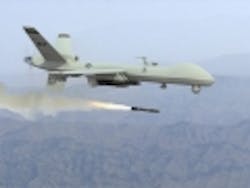DARPA seeks to develop sensor networks able to detect threats in densely populated cities
ARLINGTON, Va., 5 May 2010.Intelligence processing experts at the U.S. Defense Advanced Research Projects Agency (DARPA) in Arlington, Va., are asking industry to develop sensor networks to detect threats in densely populated cities from imaging sensors and other sources.
DARPA issued a broad agency announcement (DARPA-BAA-10-49) Monday for the Wide Area Network Detection (WAND) program to provide information processing to help detect and localize threats in cities where they are difficult to differentiate from the civilian population.
The WAND program will include automated sensor processing to detect, identify, localize, and track threats in vehicles and on foot by combining wide area motion imaging (WAMI) and other sources of data; combine the information with human intelligence and other information to estimate threat networks; and manage sensing resources to best advantage.
WAND seeks to integrate human-machine processing and human-to-human collaboration with tools that visualize sensor data, single-sensor tracks, associations of data across several sensors, threat network attributes and estimates, and sensor resource allocations.
DARPA researchers want to develop WAND to adapt to new sensor and information sources, and interface to service and intelligence community processing, exploitation, and dissemination (PED) systems.
WAND will build on advances in motion imaging and WAMI systems that can sense areas as large as tens of square kilometers at high ground sample distances, which enable reliable tracking of people on foot, as long as they remain unobscured from the view of the sensor.
A significant challenge in analyzing wide area motion imagery involves the sensor, which will potentially detect thousands to tens of thousands of objects in densely populated urban areas -- many more than a human or current-generation automated algorithms can reasonably track and analyze. It is extremely difficult to discriminate threats from non-threats, and to best focus and cue additional analysis and collection resources.
WAND will develop new WAMI tracking, multisensor correlation and resource management, threat network detection, and human-machine processing capabilities.
DARPA researchers are interested in wide area motion imaging and object tracking; other sensor collection and processing; multi-intelligence correlation and resource management; network detection; and system integration -- including modeling and simulation, flight testing and system validation and verification.
Companies interested must submit final proposals no later than 29 July 2010. For questions or concerns contact the WAND program manager, Mark Luettgen, by e-mail at [email protected], by fax at 703-807-1723, or by post at DARPA-BAA-10-49, 3701 North Fairfax Drive, Arlington, VA 22203-1714.
More information is online at https://www.fbo.gov/spg/ODA/DARPA/CMO/DARPA-BAA-10-49/listing.html.
